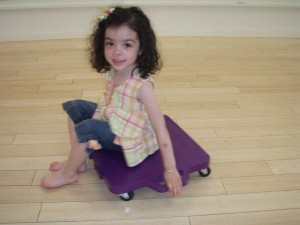If there was only one piece of equipment I was allowed to keep, it would be my scooter board. Built by my husband 28 years ago, it’s still solid as a rock and works beautifully. Countless number of children have gotten stronger, mastered critical motor skills and had fun on my scooter.
Riding a scooter works the core muscles hard! That’s why this is an all time favorite of mine. Scooters are inexpensive,* easy to store and transport. Children love them!
Benefits:
- Core strengthener
- Strengthens arms, legs and hands
- Provides a great cardiovascular workout
- Increases overall physical endurance
- The “heavy work” activates proprioceptors, which help organize the child
- Moving fast on the scooter activates the vestibular system, which can “rev” up the body and mind
- Provide an obstacle course and it becomes a motor planning enhancer
- Pulling a rope or using a plunger adds a bilateral component to improve bilateral motor coordination
- Certain methods of moving require a motor sequence
- Add a visual target and you augment eye hand motor coordination.
Directions:
Tummy Rides:
1. The child lies on the scooter with the tummy centered on the board. The top of the hips should rest at the base of the board. The mid-chest should rest at the top of the board. Shoulders and arms should be free of and solidly in front of the board.
2. The open hands push down on the floor to move forward and backwards (depending on the direction of the force exerted). Feet should stay up in the air.
Alternatives:
1. Have the child hold onto an object (band, hoola-hoop, adult’s hands) and get pulled around. The speed depends upon the child’s ability to stay securely on the scooter and enjoyment of speed).
2. Rocket blastoffs: Have the child scrunch back towards a wall with bent legs. Arms are held up (like superman flying). Say “3-2-1 Blastoff!” and the child kicks off the wall and “flies” forwards. Encourage the child NOT to use the arms to propel self forward.
3. Sitting: The child centers self on the board and uses the feet to scoot around.
4. Sitting Rides: The child holds onto an object and gets pulled around for a slow ride, a fast ride, a “whip-ride” or a crash into pillows or mats.
5. Sitting and tummy positions can both be used to play a modified sports games such as soccer and baseball for older children.
Building a scooter:
Materials:
- Heavy duty castors (found at hardware stores)
- 1 inch thick plywood
- carpet scrap to cover
- Heavy duty staples
1. Measure child’s trunk (arm pit to middle of hips) and width of the body.
2. Cut out wood to approximately this dimension (may add inches to leave room for growth).
3. Bolt in (per instruction) castors on each corner of the rectangular piece of wood-approximately 1 inch in from corner.
4. Cover carpet over wood surface and staple underneath (make sure to cover edges)
I have used the same scooter for over 28 years. Teenagers weighing 130 pounds have used this extensively!










